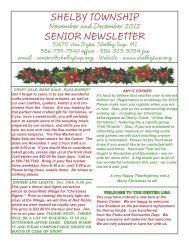RIVER BENDS PARK-WEST AND HOLLAND ... - Shelby Township
RIVER BENDS PARK-WEST AND HOLLAND ... - Shelby Township
RIVER BENDS PARK-WEST AND HOLLAND ... - Shelby Township
You also want an ePaper? Increase the reach of your titles
YUMPU automatically turns print PDFs into web optimized ePapers that Google loves.
Habitat and wildlife use: This stand was primarily a dry hardwood oak-hickory type, with minor<br />
components of maples, black cherry and shagbark hickory. Birds that live in oak-hickory forests include<br />
great-crested flycatcher, eastern wood pewee, rose-breasted grosbeak, scarlet tanager, blue jay, ovenbird,<br />
black-capped chickadee, white-breasted nuthatch, red-bellied and downy woodpeckers, northern flicker,<br />
ruffed grouse and wild turkeys 10 . White-tailed deer, squirrels, deer mice and voles are the most common<br />
mammals. Many of these species prefer and depend on acorns, but the hickory nuts with their hard shells<br />
are significant foods primarily for wood duck, wild turkey, squirrels and chipmunk. Hickory nuts and/or<br />
flowers are incidental foods in the diets of ring-necked pheasant, bobwhite quail, crow, rose-breasted<br />
grosbeak, blue jay, white-breasted nuthatch and red-bellied woodpecker. Yellow-bellied sapsuckers feed on<br />
the sap. Deer feed on leaves, twigs and nuts, white-footed mice feed on leaves and nuts, and raccoon, rabbit,<br />
gray fox and black bear feed on hickory nuts and/or bark.<br />
Recreational opportunities: This stand is a destination site as part of the Holland Ponds complex, and<br />
receives frequent visitation by patrons. The old ranger station foundation could be made much more<br />
interesting if an interpretive sign with old pictures of the building and the rangers using it, perhaps with a<br />
floor plan of the building, were assembled and erected at the site. This could be accompanied with an old<br />
map of the park or recreation area at the time the building was used. There is a side trail going east along<br />
the hilltop, with a bench in serious need of graffito removal. This particular trail was established and signed<br />
to allow visitors to get a glimpse of the heron rookery to the south. For better viewing, some tree branches<br />
or entire small trees may need to be cut out of the way at different locations along the hilltop.<br />
Potential for timber production: If timber production were a goal of the Park, this small stand may be worth<br />
managing for long-term sustainable harvest. The oaks, sugar maple and black cherry are the most valuable<br />
species in current markets. Nearly all the species in this stand provide valuable food sources and<br />
nesting/roosting sites for wildlife, so they should be maintained for that purpose. The maples are more<br />
shade tolerant than oaks and hickories, and without some kind of disturbance, such as fire, wind-throw or<br />
timber harvest, the oak-hickory forest will eventually convert to maple-beech or some other forest type 10 .<br />
This stand is very accessible by Holland Pond roads.<br />
Potential for other uses:<br />
Water quality issues: Activities in this stand which could potentially allow chemical pollutants to fall on the<br />
ground surface should be avoided, as such pollutants could migrate downhill to the swamp below.<br />
Important natural features: All the trees in this stand have importance for wildlife and people. The slopes<br />
are also important features, influencing vegetation and wildlife use.<br />
MANAGEMENT PLANS FOR 'ST<strong>AND</strong> 4. OAK-HICKORY'<br />
Landowner's objectives for this stand: Maintain this mixed hardwood/conifer forest for its aesthetic, wildlife<br />
and recreation values. If feasible, add interpretive signing next to the old ranger station foundation.<br />
Maintain the various trails in and along this stand.<br />
Silvicultural Prescription:<br />
Recommended silvicultural system: Uneven-aged management, favoring oaks, hickories, and maples.<br />
Details of the silvicultural prescription: If perpetuating the oak-hickory dominance in this stand is<br />
considered important, periodic small disturbances may be necessary to open the forest floor to sunlight,<br />
allowing oak and hickory seedlings to grow. Planting these seedlings would help the process. Alternatively<br />
30



